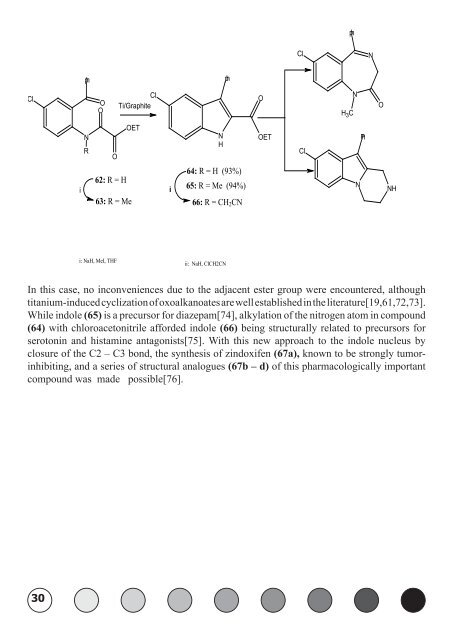Low-Valent Titanium Induced Carbonyl Coupling Reactions
Low-Valent Titanium Induced Carbonyl Coupling Reactions
Low-Valent Titanium Induced Carbonyl Coupling Reactions
You also want an ePaper? Increase the reach of your titles
YUMPU automatically turns print PDFs into web optimized ePapers that Google loves.
Cl<br />
30<br />
ph<br />
N<br />
R<br />
O<br />
O<br />
O<br />
Cl<br />
Ti/Graphite<br />
OET<br />
62: R = H<br />
i i<br />
63: R = Me<br />
i: NaH, MeI, THF<br />
N<br />
H<br />
ph<br />
64: R = H (93%)<br />
65: R = Me (94%)<br />
66: R = CH2CN<br />
ii: NaH, ClCH2CN<br />
In this case, no inconveniences due to the adjacent ester group were encountered, although<br />
titanium-induced cyclization of oxoalkanoates are well established in the literature[19,61,72,73].<br />
While indole (65) is a precursor for diazepam[74], alkylation of the nitrogen atom in compound<br />
(64) with chloroacetonitrile afforded indole (66) being structurally related to precursors for<br />
serotonin and histamine antagonists[75]. With this new approach to the indole nucleus by<br />
closure of the C2 – C3 bond, the synthesis of zindoxifen (67a), known to be strongly tumorinhibiting,<br />
and a series of structural analogues (67b – d) of this pharmacologically important<br />
compound was made possible[76].<br />
O<br />
OET<br />
Cl<br />
Cl<br />
ph<br />
C<br />
H 3<br />
N<br />
N<br />
Ph<br />
N<br />
O<br />
NH










